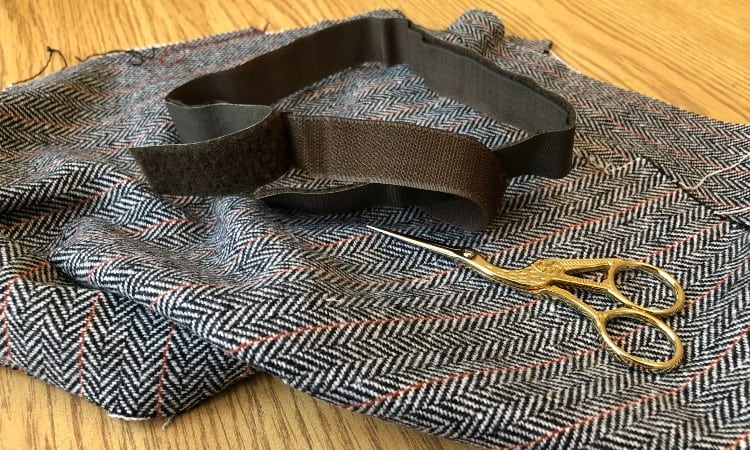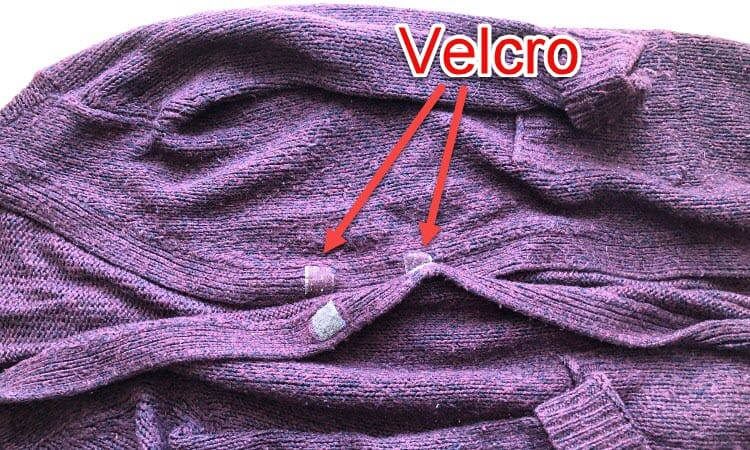Velcro has been a household name for decades. Known for making lives easier, it has uses in all sorts of projects, including those involving fabric. You’ve likely thought about trying some out in one of your own projects but wondered what fabric does Velcro stick to?
The adhesive back of the Peel and Stick Velcro will adhere to light fabrics like cotton, polyester, poly blends, and nylon. The hook side on all Velcro will adhere to any fabric consisting of small loops, such as wool, fleece, velvet, and some felt and knit fabrics.
Different types of Velcro work better on different fabrics, but there’s more to it than that. Depending on your project, you may want to go a different route entirely. In this article, we’ll walk you through your options, so you can pick the best one for you.

What Fabric Does Velcro Stick To?
Sticky back Velcro is made to stick to:
- Cotton
- Polyester
- Poly blends
- Nylon
- Most lighter fabrics
Iron-on Velcro is made to work with:
- Cotton Blends
- Polyester
- Fleece
- Suede
- Canvas
- Denim
- Nylon
- Most thicker fabrics
The “hook” side of Velcro will catch on or stick to:
- Wool
- Felt
- Nylon
- Fleece
- Microfiber
- Velvet
- Most fabric made with “small loops”
How to Make Velcro Stick to Fabric
 Adhesive Velcro comes in two varieties. The peel and stick or sticky back Velcro works just like a sticker and sticks to most lightweight fabrics. Of the options, it’s the quickest and easiest, but not the most durable. This type of Velcro is only able to be machine washed in cold water.
Adhesive Velcro comes in two varieties. The peel and stick or sticky back Velcro works just like a sticker and sticks to most lightweight fabrics. Of the options, it’s the quickest and easiest, but not the most durable. This type of Velcro is only able to be machine washed in cold water.
The second variety of adhesive Velcro is the iron-on Velcro. This Velcro takes a bit more time to adhere but should last longer than sticky back Velcro. It is best for thicker fabrics that are unsuitable for the sticky back variety or are not easily sewn.
Sew on Velcro obviously takes the most time out of the options, but will give you the strongest application. You can also machine wash your project as much as you want, and this Velcro will still hold.There is, of course, the fourth option of simply gluing on the Velcro yourself. The results will be similar to using iron-on Velcro. Additionally, once the sticky or iron-on velcro has dried in place, it too can be sewn on using a heavy needle for a more durable finish.
How to Attach Velcro to Fabric Without Sewing
Peel and Stick Velcro Instructions
- Ensure that your fabric is clean and dry. Place it on a hard, flat surface.
- Peel off the back, and press the Velcro firmly into your fabric. Make sure to work the adhesive into the fabric as well as you can. You can use a spoon to help you press it in.
- Wait 24 hours before using your fabric.
Iron-on Velcro Instructions

- Wash and dry your fabric before applying the Velcro. Place it on a hard, flat surface.
- Heat iron to the highest setting.
- Remove back of Velcro and position on fabric. You’re going to iron on the backside of the fabric with the Velcro underneath of it, so you may want to pin it into place. Do not use the iron directly on the Velcro or it will melt.
- For about 90 seconds, press down with your iron, and move back and forth. Make sure to evenly distribute the heat and avoid burning your fabric. If your fabric is delicate, you may want to use a press cloth between the iron and the fabric.
- Wait 24 hours before use.
Instructions for Gluing Velcro
- Use freshly washed and dried fabric. Place on a hard, flat surface.
- For best results, use fabric glue. Only apply a thin line of glue down the center of the back of the Velcro. You don’t want to use too much, or it can ruin your fabric. It will spread when you press it into your fabric. (You can use hot glue instead on some fabrics. However, I would avoid using it on polyester, for example, as it could melt.)
- Firmly work the glue into your fabricand the Velcro backing to ensure it stays put.
- Follow the instruction on your glue for drying times.
How to Sew Velcro to Fabric
How to Sew on Velcro Instructions
- Cut Velcro to the size and shape that you want.
- You can machine-sew or hand-sew Velcro around edges. It’s recommended that you backstitch to make it extra secure.
Do not sew on the sticky back or iron-on Velcro until it has set and dried. It is much thicker and harder to get a needle through. You will most likely break your needle, so use a heavier needle and a thimble. If the glue hasn’t dried,, it will gum up the needle with adhesive.
Does Velcro Stick to Felt?
There are many projects involving Velcro and felt. Felt is a great fabric to use with Velcro because it is made of many tiny loops of fabric, allowing the hook side (the rough side) of Velcro to adhere easily.
Be aware though, the hooks can tear the felt loops and make the felt look scruffy. Of course, if you want to use the sticky back or iron-on varieties of Velcro with felt, you can do that too. It works with all types.
Choosing the Best Velcro For Your Project
 The most important thing to ask yourself when choosing the right Velcro for your project is how durable does it need to be? How much use is your project going to get? Is it going to be used harshly or by a child?
The most important thing to ask yourself when choosing the right Velcro for your project is how durable does it need to be? How much use is your project going to get? Is it going to be used harshly or by a child?
For the most permanent solution, we recommend the traditional sew-on Velcro, but iron-on can usually get the job done too. You’ll also want to consider iron-on Velcro if you don’t want to see the stitching on your fabric.
If your project is more of a simple solution, like a temporary hem job, then sticky back Velcro is definitely the way to go. It’s so fast and easy, you’ll find yourself using it for everything. Just don’t expect it to last forever!
Velcro Alternatives for Fabric
There are many pros and cons to using Velcro on your projects, and while Velcro is probably the easiest option, it may not be the best. Namely, Velcro can get hooked on some fabrics and snag them. Luckily, there are countless alternatives.
- Zippers
- Buttons
- Snaps
- Hook and Eyes
- Laces
- Magnetic contacts
And that’s just to name a few! It depends on what you’re looking to do with your project. Do you want a quiet closure? Magnetic contacts might be better. Do you want a stronger closure? Maybe try a zipper. Play around with different ideas and see what works best for you. The possibilities are endless!
How to Fix Velcro That Won’t Stick
If you’re having trouble getting the adhesive on your Velcro to stick, make sure that you have thoroughly followed the instructions. If your fabric wasn’t freshly washed, it could have some kind of residue on it, preventing the adhesive from sticking.
Newly bought clothes often have chemicals from the dyes still on them, which can interact with the adhesive and interfere with it sticking. So definitely make sure your fabric is clean before attempting to stick on adhesive Velcro.
Make sure that you really press the adhesive into your fabric. Use a spoon, as mentioned, to smooth it out while pressing. That generally does the trick, just make sure you’re applying enough pressure.
The sticky back Velcro can only handle cold water washes or will fall off otherwise. As mentioned, this variety of Velcro isn’t usually meant as a long-term solution.
If you didn’t let your project sit for the required 24 hours, the adhesive may not have had enough time to bond fully to your fabric.
Stretchy fabrics do not usually work well with adhesive Velcro. Make sure the fabric you are trying to use with your Velcro isn’t too stretchy.
Lastly, if it’s just the actual hook and loop Velcro that isn’t sticking, make sure there isn’t any lint, hair, or debris stuck in it. You can use a toothbrush or duct tape to remove the dirt, making it good as new and ready to use.
How to Remove Velcro From Fabric
Some varieties of Velcro will be much easier to remove than others, so keep that in mind when choosing which Velcro to use for your project.
Sticky back Velcro will usually be the easiest to remove. Simply peel up as much as possible with one hand, while holding your fabric down with the other. You can slide a plastic card underneath the Velcro to try and pry the rest up if need be. Just make sure not to rip your fabric.
If there is any sticky residue left behind, it should come out in the wash or with some warm water and dish soap. Alternatively, a blow dryer or heat gun works to loosen Velcro adhesive on non-synthetic fabrics.
Iron on Velcro is going to be a bit trickier. The best way to loosen the adhesive bond is by applying heat. You can use your iron to gently move back and forth over the fabric and reheat the adhesive. Pull the Velcro and the fabric apart while it is still warm.
You can also use a hairdryer while pulling up the Velcro the same way you would the sticky back kind. You will have to attempt to melt and peel off any residue left behind. You can use newspaper over the residue and use your iron to heat it up.
Take a butter knife and try to scrape off what you can. Afterward, you can rub mineral spirits on the fabric to try and get any leftovers off. Mineral spirits are not likely to cause damage to your fabric, but I would still only use them as a last resort.
 Sew on Velcro is easy to remove if you have a seam ripper.
Sew on Velcro is easy to remove if you have a seam ripper.
Just pull back the Velcro as much as possible without damaging your fabric, and reveal a stitch. Just cut the exposed stitch and keep revealing and cutting more until you get the Velcro off.
You can use scissors or a sharp knife to do this as well, but it’s much easier with the seam ripper.
Conclusion
Many fabrics can be used with Velcro, making endless fun projects! Whether you’re sewing your child’s Halloween costume, or simply keeping the collar on your shirt where it needs to be, Velcro could become your go-to. How have you used Velcro in your fabric projects?
